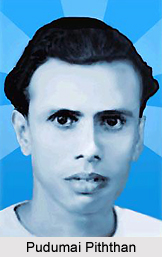 Short story in twentieth century Tamil Literature has grown in rather a big way. One of the earliest short story writers in Tamil Literature was Va. Ve. Su. Iyer (1881-1925). In all the short stories in his collection Mangaiyerkkarasiyin Kadal (The Love of Mangaiyerkkarasi, 1910-20), Iyer exploited the now well-known techniques of beginning his narrative in medias res (meanin to plunge the readers right into the middle of the action) and of offering psychological insights into the actions of his characters in order to infuse a feeling and truth into his short stories. Iyer introduced two of the most famous love stories in the world-those of "Laila Majnu" and "Anarkali"- through the medium of the short story to the Tamil-speaking world. Iyer also pioneered the tale of social satire and reform through his short story "Kulaththangkarai Arasa Maram" (The Arasu Tree at the Edge of the Temple Tank).
Short story in twentieth century Tamil Literature has grown in rather a big way. One of the earliest short story writers in Tamil Literature was Va. Ve. Su. Iyer (1881-1925). In all the short stories in his collection Mangaiyerkkarasiyin Kadal (The Love of Mangaiyerkkarasi, 1910-20), Iyer exploited the now well-known techniques of beginning his narrative in medias res (meanin to plunge the readers right into the middle of the action) and of offering psychological insights into the actions of his characters in order to infuse a feeling and truth into his short stories. Iyer introduced two of the most famous love stories in the world-those of "Laila Majnu" and "Anarkali"- through the medium of the short story to the Tamil-speaking world. Iyer also pioneered the tale of social satire and reform through his short story "Kulaththangkarai Arasa Maram" (The Arasu Tree at the Edge of the Temple Tank).
Pudumai Piththan (1906-48), following in the footsteps of Iyer, brought about a revolution in the world of the Tamil short story. He highlighted the social evils and shortcomings of contemporary Tamil society by using subtle sarcasm and outright mockery in his works. He presented such realistic depictions in his works that he gathered a lot of criticism from many sections of people. Most notable among his creations are gems such as "Kadavulum Kandasami Pillaiyum" (God and Kandasami Pillai) and "Sabha Vimochanam" (The Curse Repealed).
The short stories of Kalki, pseudonym of R. Krishnamurthi (1809-1954), captivated all sorts and conditions of people because of their combination of high ideals and rich humour. A number of his short stories even campaigned effectively against prominent social evils such as drinking and un-touchability. "`Kedariyin Amma" (Kedari`s Ma) and "Thirudan Mahan Thirudan" (Thief`s Son`s a Thief) are two of his outstanding stories. Akilan was one of the most outstanding writers who followed the example set by Kalki. His short stories such as "Ganga Snanam" (A Dip in the Ganges), "Kuraththi" (Gypsy Woman), and "Kuzhandai Chiriththathu" (The Child Laughed), reinforced the ideals of the Tamil culture without in any way ignoring the struggles faced in modern Tamil society.
While T. Janaki Raman (1921), author of innovative short stories such as "Chilirppu" (Shiver) and "Sivappu Riksha" (The Red Riksha), was a fine writer who was able to plumb into the deepest depths of the human heart and bring out the hidden feelings there.
K. Raja Narayanan was remarkable for his exploitation of colloquial speech rhythms and Tamilian village traditions in his short stories.
Jaya Kanthan has done an outstanding job of exploring the lives of slum dwellers with such fidelity and sympathy. To him also belongs the credit of introducing deep desires of human beings into the world of the Tamil short story with the ultimate aim of providing psychological insights into some dark corners of the human mind. "Agni Pravesham" (The Test of Fire) and "Suya Darisanam" (Self-Recognition) are among his best short stories. Among women writers, R. Choodamani is outstanding for the vivid imagery and sensitiveness of her short stories, while Siva Sankari is known for her concern with women`s needs and rights.
Today, the short story is a fast-growing phenomenon in Tamil. Many fine male writers, like Chu. Samudiram and Bala Kumaran, as well as female writers, such as Ambai and Vasanthi, are enriching the world of the Tamil short story. Popular magazines like Ananda Vikatan, Kalki, Kalaimagal and Kumudam, as well as literary journals like Kanaiyazhi, Chemmalar, and Subha Mangala, provide outlets for writers of every kind, from those promoting lofty ideals to those with crass commercial motives. Short story collections, too, appear regularly and generally sell well.













